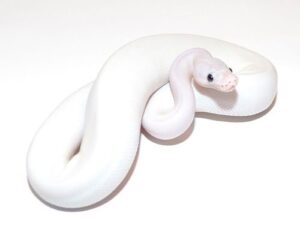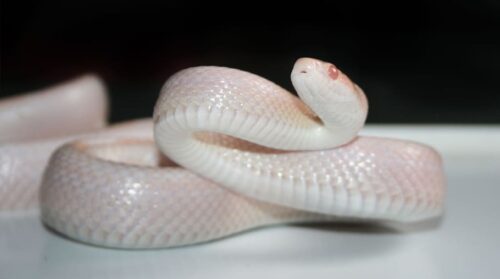If you’re a reptile enthusiast or someone simply curious about the world of exotic pets, you may have encountered the stunning beauty of albino snakes. These reptiles, with their striking pale coloration, have captured the attention of many snake lovers worldwide. Albino snakes are known for their distinctive white or yellowish bodies, often highlighted by their red or orange eyes, making them stand out in the world of snakes.
But there’s so much more to these snakes than just their appearance. From their unique biology to the care they require in captivity, this guide will take you through everything you need to know about albino snakes.
What Is an Albino Snake?

Albino snakes are a type of snake that carries a genetic mutation known as albinism, which results in a lack of melanin in their skin. Melanin is the pigment responsible for the typical coloration of animals, and its absence causes albino animals to have a pale or white appearance.
But while the term “albino” is commonly used, it’s important to note that there is a distinction between albino and leucistic animals. Leucism refers to a condition where the animal is pale but still retains some coloration in the eyes, while albinism results in a complete absence of melanin, giving the animal a much lighter appearance.
In the case of albino snakes, the lack of melanin often gives them their signature white, yellow, or light-colored skin. Their eyes typically appear as a reddish-pink or even bright red hue, which further accentuates their otherworldly look.
Genetics of Albino Snakes
The genetic mutation that causes albinism is recessive, meaning that both parents must carry the gene for their offspring to express the albino phenotype. Breeders take advantage of this recessive trait to produce albino morphs of different snake species, making these reptiles more widely available in captivity.
Types of Albino Snakes
Several species of snakes have albino morphs, and each one brings something unique to the table. Here are some of the most popular albino snake types:
1. Albino Ball Python
The Albino Ball Python is one of the most well-known albino snake breeds. These snakes are often sought after for their calm temperament, making them a popular choice for snake enthusiasts. Their scales range from pale yellow to off-white, and their red eyes add to their allure.
2. Albino Corn Snake
The Albino Corn Snake is another popular morph. With its orange and red hues, an albino corn snake looks even more vibrant, and its smaller size makes it an excellent choice for beginners. It’s often more affordable than some other albino morphs.
3. Albino Burmese Python
A much larger species, the Albino Burmese Python can grow up to 16 feet long. These snakes are an investment for those who have the space and experience to care for such a large reptile. Their light golden-yellow color contrasts with their darker, almost brownish patterns, making them a showstopper in any reptile collection.
4. Albino California Kingsnake
The Albino California Kingsnake is a less common albino morph but certainly a fascinating one. It has a striking contrast of white and yellow with occasional black bands, which makes it stand out from the typical black-and-white coloration of non-albino California kingsnakes.
5. Albino Boa Constrictor
The Albino Boa Constrictor is an exotic choice for snake owners. These snakes are known for their beautiful patterns and calm nature. The albino version tends to have a pale background with reddish or yellow tones, giving it an almost ghostly appearance.
Albino Snakes in the Wild vs Captivity
In the wild, albino snakes are incredibly rare. This is due to their genetic mutation, which makes them more susceptible to predation. The lack of pigmentation not only makes them easy targets for predators but also can make it difficult for them to blend into their environment. As a result, albino snakes are not commonly found in the wild.
However, in captivity, albino snakes thrive due to controlled environments that keep them safe from predators. Captive breeding programs have made albino snakes more accessible to reptile enthusiasts, and they are often bred in specialized facilities for sale to pet owners. Many albino snake species are now selectively bred to create specific color morphs, making them available for various collectors and hobbyists.
Albino Snake Care Guide

Caring for an albino snake is similar to caring for any other snake, but there are a few extra considerations you should be aware of to ensure their health and well-being.
1. Habitat Setup
Albino snakes don’t require different types of enclosures than other snakes. However, their lighting needs are slightly different due to their sensitivity to bright lights. Since albino snakes lack pigmentation, they can be more sensitive to intense light. It’s important to provide a more subdued light environment for them.
| Albino Snake Species | Recommended Enclosure Size | Substrate | Temperature Range |
|---|---|---|---|
| Albino Ball Python | 40-50 gallons (medium to large) | Aspen or coconut husk | 75°F to 85°F (24°C to 29°C) |
| Albino Corn Snake | 20-30 gallons (medium) | Newspaper or aspen | 75°F to 85°F (24°C to 29°C) |
| Albino Burmese Python | 100 gallons (extra-large) | Aspen or coconut husk | 75°F to 85°F (24°C to 29°C) |
| Albino California Kingsnake | 30 gallons (medium) | Aspen or cypress mulch | 75°F to 85°F (24°C to 29°C) |
2. Temperature and Lighting
Albino snakes, like other reptiles, require a heat source to regulate their body temperature. Typically, a heat lamp or a heat mat placed under one side of their enclosure works best to create a thermal gradient. Ensure they have a cooler area in the tank to retreat to if they need to cool down.
As for lighting, UVB light isn’t necessary for albino snakes in the same way it is for some other reptiles, but providing a cycle of light and darkness (12 hours on, 12 hours off) is essential for their circadian rhythm.
3. Feeding
Feeding albino snakes is simple but depends on their size. Young snakes require smaller prey, such as pinky mice, while adults may need larger prey, like adult mice or rats.
-
Feeding Frequency: Hatchlings and juveniles should be fed once a week, while adult snakes can be fed every 10-14 days.
-
Prey Size: Prey should be about 1.5 times the size of the snake’s girth for optimal health.
4. Handling Tips
Albino snakes are generally calm and tolerant of handling, though it’s important to handle them gently. Over-handling can cause stress, so aim for 10-15 minute sessions a few times a week. Always wash your hands before and after handling your snake to maintain both your hygiene and that of the snake.
5. Health Concerns
Like all snakes, albino snakes can develop health issues if not properly cared for. Some of the common health concerns include:
-
Skin shedding problems: Albino snakes may experience difficulty shedding due to humidity or dehydration.
-
Light sensitivity: Excessive exposure to bright light can cause stress or harm to albino snakes.
-
Respiratory infections: Keep their enclosure clean to avoid bacterial or fungal infections.
Are Albino Snakes Good Pets?
Albino snakes make excellent pets for both beginners and experienced reptile owners. Their calm nature and relatively simple care requirements make them suitable for novice keepers, but they can also be a great addition to more experienced collections.
If you’re prepared for their specific lighting and habitat needs, you will find that albino snakes are a rewarding pet.
Price and Availability
Albino snakes, due to their rarity and genetic mutation, tend to be more expensive than regular snakes. The price varies by species, age, and even specific morphs. For example, an albino ball python can cost anywhere from $100 to $500, while an albino Burmese python can cost upwards of $1,000 or more, depending on its size and quality.
It’s essential to buy your albino snake from a reputable breeder who practices ethical breeding. Always research the breeder and ensure the snake is healthy before making a purchase.
Legal and Ethical Considerations
Before getting an albino snake, ensure that owning one is legal in your state or country. Some regions have regulations concerning the ownership of exotic animals, so it’s important to verify local laws.
Also, consider ethical breeding practices. Ethical breeders focus on the health and well-being of the snakes, and they do not breed solely for profit. Avoid purchasing snakes from unethical sources, as this can contribute to the mistreatment of the animals.
Albino Snake Myths & Misconceptions
Albino snakes are often surrounded by myths and misconceptions. For instance, some people believe albino snakes are blind, but this is not true. Albino snakes have normal vision; they simply have pale eyes due to the lack of pigmentation.
Another common myth is that albino snakes are inherently aggressive or dangerous, but this is far from the case. Most albino snake species are calm and non-aggressive, making them great pets.
Conclusion
Albino snakes are among the most visually striking and unique reptiles you can keep as pets. From their unusual genetic makeup to their fascinating appearance, they are a standout in the world of snakes.
Whether you choose an albino ball python, an albino corn snake, or any other species, you’ll find that these snakes make calm, captivating companions. Proper care, ethical breeding, and a clear understanding of their needs will help ensure that your albino snake thrives in captivity.

